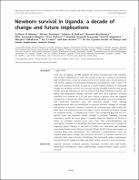| dc.identifier.citation | Mbonye, A.K., Sentongo, M., Mukasa, G.K., Byaruhanga, R., Sentumbwe-Mugisa, O., Waiswa, P., Naamala Sengendo, H., Aliganyira, P., Nakakeeto, M., Lawn, J.E. and Kerber, K., 2012. Newborn survival in Uganda: a decade of change and future implications. Health policy and planning, 27(suppl_3), pp.iii104-iii117. | en_US |
| dc.description.abstract | Each year in Uganda 141 000 children die before reaching their fifth birthday; 26% of these children die in their first month of life. In a setting of persistently high fertility rates, a crisis in human resources for health and a recent history of civil unrest, Uganda has prioritized Millennium Development Goals 4 and 5 for child and maternal survival. As part of a multi-country analysis we examined change for newborn survival over the past decade through mortality and health system coverage indicators as well as national and donor funding for health, and policy and programme change. Between 2000 and 2010 Uganda’s neonatal mortality rate reduced by 2.2% per year, which is greater than the regional average rate of decline but slower than national reductions in maternal mortality and under-five mortality after the neonatal period. While existing population-based data are insufficient to measure national changes in coverage and quality of services, national attention for maternal and child health has been clear and authorized from the highest levels. Attention and policy change for newborn health is comparatively recent. This recognized gap has led to a specific focus on newborn health through a national Newborn Steering Committee, which has been given a mandate from the Ministry of Health to advise on newborn survival issues since 2006. This multi-disciplinary and inter-agency network of stakeholders has been able to preside over a number of important policy changes at the level of facility care, education and training, community-based service delivery through Village Health Teams and changes to essential drugs and commodities. The committee’s comprehensive reach has enabled rapid policy change and increased attention to newborn survival in a relatively short space of time. Translating this favourable policy environment into district-level implementation and high quality services is now the priority. | en_US |


